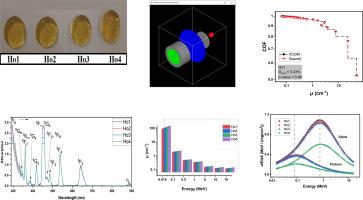氧化锌和CaO修饰的ho2o3掺杂硼酸盐玻璃的光学、光子相互作用和辐射屏蔽性能
IF 5.7
3区 材料科学
Q2 MATERIALS SCIENCE, MULTIDISCIPLINARY
引用次数: 0
摘要
本文采用熔融淬火技术合成了一系列ZnO和CaO修饰的ho2o3掺杂硼酸盐基玻璃,并对其进行了系统的研究。加入修饰剂后,实验质量密度由2.98 g/cm3提高到3.29 g/cm3,直接提高了光子相互作用概率。Tauc图分析表明,光学带隙从3.879 eV减小到3.739 eV。Geant4蒙特卡罗模拟与XCOM的预测非常吻合,偏差低于4%,进一步由Kolmogorov-Smirnov检验验证(Dmax < 0.89%, p ~ 1)。在0.5 MeV下,线性衰减系数(μ)在0.260 ~ 0.287 cm-1之间,优于几种标准屏蔽材料。本文还对不同的屏蔽参数进行了计算和评价。SRIM分析表明,在能量较低时停止功率达到峰值,α粒子比质子具有更高的- dE/dx和更短的范围。总的来说,高透明度、密度驱动的光子衰减和稀土的结合使这些玻璃系统在光学器件、医疗窗口和辐射防护方面有前景。本文章由计算机程序翻译,如有差异,请以英文原文为准。

Optical, photon interaction, and radiation shielding performance of Ho2O3-doped borate glasses modified with ZnO and CaO
In this work, a series of Ho2O3-doped borate-based glasses modified with ZnO and CaO were synthesized using the melt-quenching technique and systematically investigated. The experimental mass density increased from 2.98 g/cm3 to 3.29 g/cm3 with modifiers, directly enhancing photon interaction probability. The Tauc plot analysis showed a decrease in optical band gap from 3.879 to 3.739 eV. Geant4 Monte Carlo simulations agreed well with XCOM predictions, with deviations below 4 %, further validated by the Kolmogorov-Smirnov test (Dmax < 0.89 %, p ∼1). At 0.5 MeV, linear attenuation coefficient () ranged from 0.260 cm-1 to 0.287 cm-1, surpassing several standard shielding materials. Different shielding parameters have also been calculated and assessed in this study. SRIM analysis showed stopping powers peaking at low energies, with alpha particles exhibiting higher −dE/dx and shorter ranges than protons. Overall, the combination of high transparency, density-driven photon attenuation, and rare-earth contributions make these glass systems promising for optical devices, medical windows, and radiation protection.
求助全文
通过发布文献求助,成功后即可免费获取论文全文。
去求助
来源期刊

Materials Research Bulletin
工程技术-材料科学:综合
CiteScore
9.80
自引率
5.60%
发文量
372
审稿时长
42 days
期刊介绍:
Materials Research Bulletin is an international journal reporting high-impact research on processing-structure-property relationships in functional materials and nanomaterials with interesting electronic, magnetic, optical, thermal, mechanical or catalytic properties. Papers purely on thermodynamics or theoretical calculations (e.g., density functional theory) do not fall within the scope of the journal unless they also demonstrate a clear link to physical properties. Topics covered include functional materials (e.g., dielectrics, pyroelectrics, piezoelectrics, ferroelectrics, relaxors, thermoelectrics, etc.); electrochemistry and solid-state ionics (e.g., photovoltaics, batteries, sensors, and fuel cells); nanomaterials, graphene, and nanocomposites; luminescence and photocatalysis; crystal-structure and defect-structure analysis; novel electronics; non-crystalline solids; flexible electronics; protein-material interactions; and polymeric ion-exchange membranes.
 求助内容:
求助内容: 应助结果提醒方式:
应助结果提醒方式:


